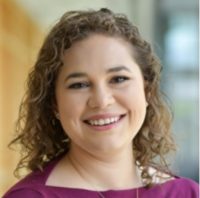Pictured: Megan Beers Wood
Along with our partner, the Hearing Health Foundation, we are excited to announce our Emerging Research Grant for 2022. This grant demonstrates our commitment to uncover the mechanisms associated with hyperacusis on our path to a cure. We are extremely grateful for our donor support which makes this grant possible. The grant goes to Megan Beers Wood, Ph.D., of the Johns Hopkins University School of Medicine, who will be studying type II auditory nerve fibers as instigators of the cochlear immune response after acoustic trauma.
A subset of patients with hyperacusis experience pain in the presence of typically tolerated sound. Little is known about the origin of this pain. One hypothesis is that the type II auditory nerve fibers (type II neurons) of the inner ear may act as pain receptors after exposure to damaging levels of noise (acoustic damage). Our lab has shown that type II neurons share key characteristics with pain neurons: They respond to tissue damage; they are hyperactive after acoustic damage; and they express genes similar to pain neurons, such as the gene for CGRP-alpha. However, type II neurons are not the only cell type that responds to acoustic damage. The immune system responds quickly after damaging noise exposure. In other systems of the body such as the skin, CGRP-alpha can affect immune cell function. This project looks at the expression of CGRP-alpha in type II neurons after noise exposure. CGRP-alpha will be blocked during noise exposure to see if this affects the immune response to tissue damage.


Any updates on this study? I’d love to know about the ongoing research from this foundation.
I am a local Baltimore Resident and Hopkins Patient with Hyperacusis, can I be a part of this or help?
Mike, thanks for posting. The Johns Hopkins University research presently resides in the laboratory and not yet with human subjects. You may wish to email the researchers, to let them know you are local, and a current Hopkins patient, in case there could be an opportunity. If you read our recent interview with Dr. Megan Beers Wood of Johns Hopkins, you will note she places importance on hearing patient stories. So she might be interested to hear from you, and your story. You are also welcome to submit your story for publication on our website, we are always looking for new patient stories. Here is the link to the interview with Dr. Wood: https://hyperacusisresearch.org/meet-the-researcher-a-talk-with-megan-beers-wood-recipient-of-our-emerging-research-grant/.
How does a person with Hyperacusis get involved with a support group?